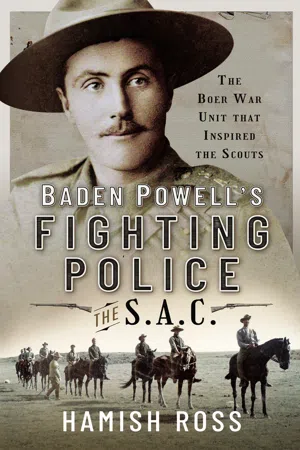
eBook - ePub
Baden Powell's Fighting Police—The SAC
The Boer War unit that inspired the Scouts
- 224 pages
- English
- ePUB (mobile friendly)
- Available on iOS & Android
eBook - ePub
About this book
This work begins in August 1900 during the war in South Africa, when mounted Boer commandos ranging across the veldt superseded pitched battles of massed armies and heavy weaponry. Thanks to his flair for organisation, Baden-Powell is asked to create a mounted force with a combined military and police role, and will be answerable to the Commander-in-Chief and the civil High Commissioner. Rejecting Army models of command, Baden-Powell creates the South African Constabulary (SAC) with a small number of officers, dividing it into Troops of 100 men, then sub-dividing again into sections and the key working unit – the squad of six men under a corporal. To get the calibre of recruit he wants, the SAC will be better paid than the Army and he expects the men to be motivated by a code of honor, to be self-reliant and 'handy men' able to tackle any kind of work. Most recruits come from the UK, but in Canada, however, the Governor General intervenes and botches selection. The SAC's effectiveness comes to light in this book – the first that deals with its creation and development; its wartime achievements and its peace-time transition into a community support helping local people returning to their homes. This work also highlights what Baden-Powell brought from the SAC and gave anew to the Scouts. Based on research using archive material in the UK, South Africa and Canada, it also includes images that have not previously appeared before in the public domain.
Frequently asked questions
Yes, you can cancel anytime from the Subscription tab in your account settings on the Perlego website. Your subscription will stay active until the end of your current billing period. Learn how to cancel your subscription.
At the moment all of our mobile-responsive ePub books are available to download via the app. Most of our PDFs are also available to download and we're working on making the final remaining ones downloadable now. Learn more here.
Perlego offers two plans: Essential and Complete
- Essential is ideal for learners and professionals who enjoy exploring a wide range of subjects. Access the Essential Library with 800,000+ trusted titles and best-sellers across business, personal growth, and the humanities. Includes unlimited reading time and Standard Read Aloud voice.
- Complete: Perfect for advanced learners and researchers needing full, unrestricted access. Unlock 1.4M+ books across hundreds of subjects, including academic and specialized titles. The Complete Plan also includes advanced features like Premium Read Aloud and Research Assistant.
We are an online textbook subscription service, where you can get access to an entire online library for less than the price of a single book per month. With over 1 million books across 1000+ topics, we’ve got you covered! Learn more here.
Look out for the read-aloud symbol on your next book to see if you can listen to it. The read-aloud tool reads text aloud for you, highlighting the text as it is being read. You can pause it, speed it up and slow it down. Learn more here.
Yes! You can use the Perlego app on both iOS or Android devices to read anytime, anywhere — even offline. Perfect for commutes or when you’re on the go.
Please note we cannot support devices running on iOS 13 and Android 7 or earlier. Learn more about using the app.
Please note we cannot support devices running on iOS 13 and Android 7 or earlier. Learn more about using the app.
Yes, you can access Baden Powell's Fighting Police—The SAC by Hamish Ross in PDF and/or ePUB format, as well as other popular books in History & 19th Century History. We have over one million books available in our catalogue for you to explore.
Information
Table of contents
- Cover
- Title
- Copyright
- Contents
- Preface
- Acknowledgements
- Part I
- Part II
- Part III
- Part IV
- Appendix: Notes and Instructions for the South African Constabulary
- Notes
- Bibliography
- Plate section